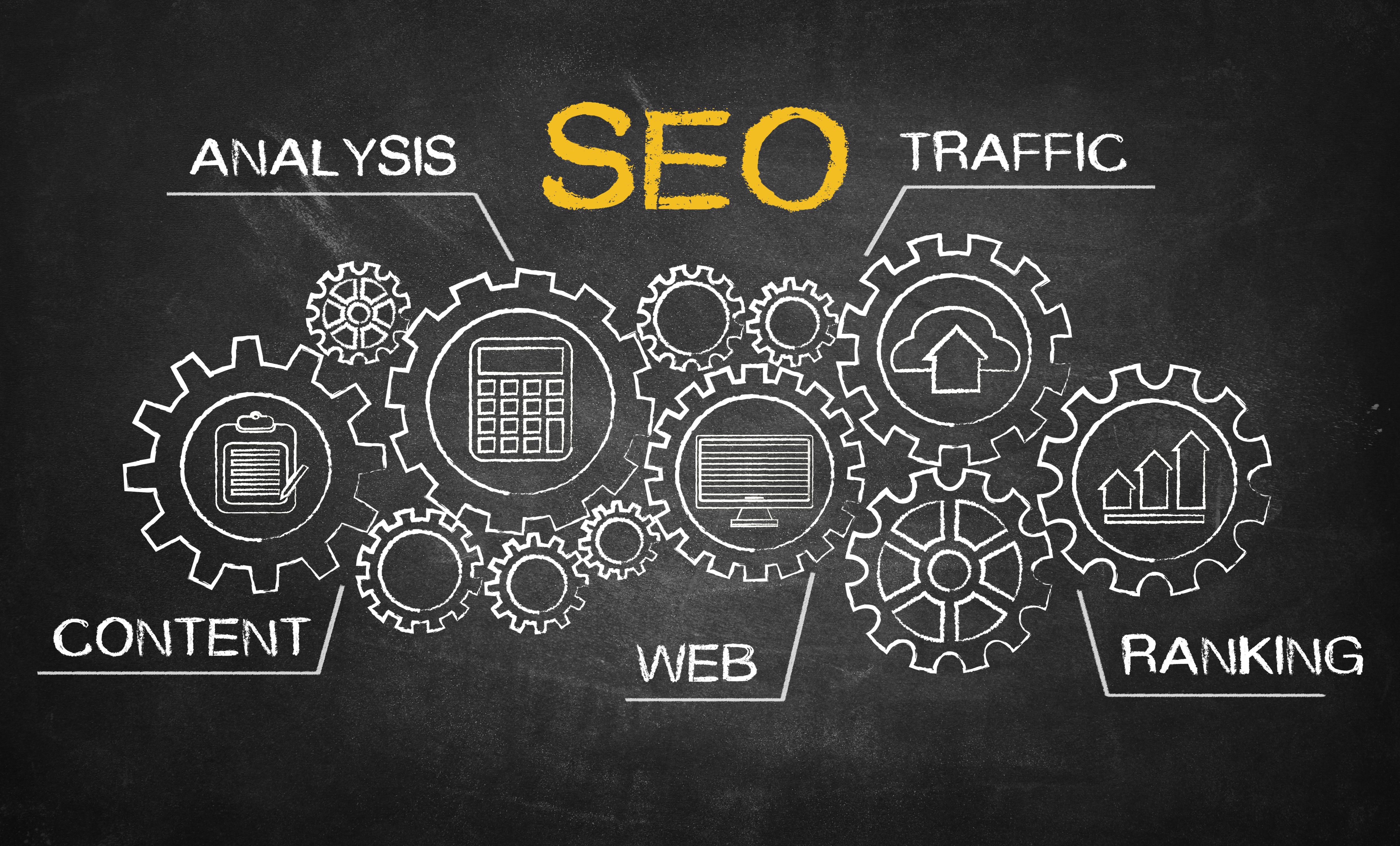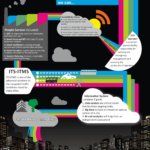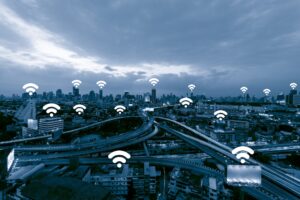
12 April, 2021Uncategorized
With the expansion of urbanisation, countries all over the world are developing ambitious technology driven large-scale smart cities that are fully monitored and controlled. This is done through unified platforms that incorporate smart electricity, water and gas meters, smart street lighting, smart waste management and smart parking among other IoT applications.
The success of such smart cities requires seamless integration between the different parts of the puzzle including unified billing mechanisms and the incorporation of robust, reliable and secure communication infrastructure.
In today’s modern distribution sector, utilities for electricity, water and gas mostly have complete autonomy allowing them to explore unique and interesting communication technologies and integration techniques that are largely un-standardised matching their current needs and expectations.
However, once the inevitable transformation to smart cities happens in search of greater efficiency, lower operational expenditure and higher quality services for citizens, these utilities will feel like islands that are unable to mesh together. In order to avoid this pitfall key stakeholders including governmental regulators, utilities, system integrators and solution providers must have the foresight to realise that strategic investment in future-proof smart metering technology is an integral part of establishing successful smart cities: acting as the catalyst for transformation that will help resolve interoperability issues and ensure that today’s deployed technology stands the test of time.
The leap from smart meters to smart cities requires a multi-layered approach that starts with the incorporation of smart water and smart gas meters together with the electricity meters. This raises the bar for project developers and solution providers to plant the seeds for seamless future integration between these currently independent solutions regardless of whether the infrastructure is ready today or not. To do so, we need to start by ensuring that all electricity, water and gas metering products are DLMS compliant, thereby guaranteeing that the foundation upon which the solution is built is solid. This means the incorporation of smart electricity, water and gas meters onto a unified platform would be a smooth process.
The second layer to consider is the type of communication itself because it isn’t simply enough to unify the smart metering foundation through DLMS but to also explore issues such as lack of necessary integration of communication standards across smart cities. Using broad terminology such as IoT opens the door for proprietary or vendor-specific technologies to creep in, hampering the integration process. Therefore, it is imperative for our stakeholders to seamlessly build a hybrid wired and wireless communication infrastructure that allows for the inclusion of international open protocols and universally adopted key enablers of smart grids. This includes PRIME PLC, TCP-IP for wired fibre optic networks, RF, NB-IoT and 3G-4G if cost-effective (one-size fits all doesn’t work). To do this might seem impossible given the variety and the fact that communication technology is constantly evolving.
What might work today will likely not be applicable or feasible for tomorrow’s smart grid, so we need to introduce a simple RS-485 interface onto our electricity, water and gas meters that allows any open standard communication technology to be utilised, thereby future-proofing smart metering solutions.
Other important factors to consider where smart cities are concerned include the importance of using highly reliable, costeffective, ubiquitous, secure and robust wired communication (if applicable) as the backbone for our hybrid communication network.Capitalising on the superior fibre optic network coverage that is commonly available in any smart city project by linking vendor solution onto it should also be undertaken. Reputable associations and alliances of utilities, meter vendors, technology providers and international consultants naturally have a critical role to play in this key area helping to shape the future of smart cities everywhere.
They must work closely to define unified open standards for wired and wireless communication (some technologies such as those related to radio frequency (RF) remain largely un-standardised despite their utilisation on a very wide scale, foreshadowing their withdrawal in the smart cities of tomorrow).
Another important piece of the puzzle for the effective deployment of a smart cities platform is the smooth integration between the different application layers (HES, MDMS, IoT, etc…) using internationally recognised open protocols such as multispeak, culminating in the offering of flexible unified service portals, mobile apps, point-of-sale, ATMs – through which citizens would be able to handle all of their collective billing needs.
This approach was adopted to great effect by El Sewedy EMG in smart electricity metering projects across the MEA region including Egypt (63,000 meters), Ghana (200,000 meters), and Lebanon (470,000 meters). In these projects a simple yet effective methodology was implemented that relies on DLMS compliant meters with hybrid open international standard communication technologies. For example, the flexibility offered by cutting-edge wired PRIME PLC v1.4 technology in the CENELEC and FCC bands made it possible to overcome a multitude of challenges (chief among them being the high noise and attenuation levels) hampering remote communication in Egypt’s first large-scale smart meter deployment. These installed metering solutions will in the near future seamlessly integrate with the smart water and gas meters and become a part of the smart cities platform once mandated by the respective governments in each country.
As part of its smart city initiatives, El Sewedy EMG is also meticulously developing multi-layered communication infrastructure solutions and taking strides to address the needs of smart cities. This includes the launch of a DLMS-compliant unified electricity, water and gas metering solution utilising reliable and future-proof wired RS-485 communication for the new administrative capital and smart cities project in Egypt. This is being done in conjunction with the implementation of different proof-of-concepts utilising NB-IoT across the globe. Together with its partners at the PRIME Alliance, the company has also started working on standardising key communication technologies and hopes to announce some of this initiative’s key activities and achievements over the coming months. SEI
About the company
El Sewedy Electrometer Group is one of the leading providers of end-to-end electricity, water and gas smart metering solutions and services, with facilities operating worldwide and a broad range of versatile smart solutions and products tailored to manage utilities better.
Smarter Metering for Smart Cities
IMAGINE A CITY that uses its own real-time data to solve real problems. These concepts of smart cities and the Internet of Things (IoT) have become increasingly more mainstream and are no longer a futuristic idea. Yet many municipalities may not know where to begin or if IoT-driven initiatives are financially feasible to take on. A smart, sustainable, advanced metering strategy for water and other utilities can be a great starting point, and these projects are more within reach than many states, cities, and towns might assume. Smart water infrastructure projects like this are an opportunity to use technology and data to capture lost revenue, improve sustainability and efficiency, and offer a higher quality of service to residents.
DEFINING A SMARTER APPROACH TO WATER EFFICIENCY
A smart city is future-ready, connected, and sustainable, turning data into improved operations for the municipality and better quality of life for residents. A city’s entire infrastructure can be the backbone and physical framework for the connected technologies for smart city strategy, and as such, smart metering for water and other utilities is a chance to take steps toward a more connected municipality overall.
Smart water metering means that networked, centralized water and wastewater systems leverage data from connected technologies to improve overall operations. Public works departments can use the data to pinpoint existing and potential leaks, compare year-over-year consumption levels, track customer payments, and provide information on how water usage varies by type of business or size of home. This not only streamlines management in the moment, but helps municipal leaders define priorities for the future as it relates to sustainability, infrastructure maintenance, overall system performance, and more.
Making a smart meter upgrade a reality does not have to be financially out of reach. For municipalities that enter into Energy Performance Contracts and contingent payment programs, projects are designed so that operational and energy savings uncovered by the upgrade are equal to or greater than the cost of the project itself. This offsets the initial investment and has a neutral impact on the customer’s budget over the course of the implementation. Another alternative funding option is a public-private partnership, which transfers the risk of the project to the private sector in exchange for guaranteed service and fixed payment terms over a determined period. With alternative funding methods like these, municipalities can upgrade infrastructure to improve operations without raising or creating new taxes for residents.
The Metropolitan Water Reclamation District of Greater Chicago is seeking a visionary Executive Director. The District is an award-winning wastewater agency which has been a leader in protecting the Chicago area water environment for over a 120 years. For information and to apply. The District is an Equal Opportunity Employer.
CAPTURING LOST REVENUE WITH LEAK DETECTION TECHNOLOGY
Across the US, it’s estimated that about 6 billion gallons of water are lost due to leaks each day. Leak detection systems are a critically important element for capturing lost revenue and determining opportunities to reduce wasted resources.
With daily monitoring of city-wide water distribution, departments of public works can gain valuable insight into unseen issues. A smart leak detection system uses acoustic signatures to detect potential leaks, using sensors mounted on customer service lines upstream of water meters. The sensors pick up on vibrations caused by leakages, recording the data and uploading it to a proprietary website to be analyzed. The data is next used to map potential leaks and suggest priorities for maintenance based on the severity of leaks throughout the city. By exporting this information into a work order management system, DPW employees can head out to fix the issues, using noise correlators to locate the leaks that are causing the largest loss of resources.
This approach not only reduces lost water but helps to limit any damage to surrounding buildings and roads that would result from these leaks going undetected. Water department employees would have the opportunity to stay a few steps ahead of potentially avoidable water damage, such as sinkholes or damaged infrastructure.
EMPOWERING PUBLIC WORKS DEPARTMENTS WITH CRITICAL INFORMATION
With technologies like leak detection and centrally managed systems, public works departments are armed with the information necessary to define needs and strategize for a more efficient approach to water management in the future. For example, in addition to providing data on water usage and locating leaks, reporting can give insight to water resource recovery facilities to tailor operations and define needs based on real-time information. This can range from actual running capacity versus the facility’s design capacity, the remaining life of assets, spending on unplanned maintenance, status of facility security, and average daily energy spent.
With these reporting capabilities, the need for human supervision and management of equipment in water resource recovery facilities is reduced. When paired with work order and maintenance management systems, departments can optimize labor across the board by freeing up employees to focus on other pressing priorities.
This clear, actionable information about the various maintenance needs or leakage issues across water operations allows departments to quickly prioritize and schedule maintenance to proactively mitigate any issues that might result in costly overtime for the department. Without insight into operational issues or maintenance needs, problems that go undetected can also result in urgent repairs that disrupt traffic flow, safety, and water service to customers.
Join us in Atlanta August 18–22, 2019 for StormCon, a five-day special event to learn from experts in various water-related arenas. Share ideas with peers in your field and across industries—exploring new stormwater management practices and technologies.
IMPROVING SERVICES FOR RESIDENTS
Most people don’t interact much with their local department of public works, but the data provided by smart metering allows municipalities to improve customer service by more proactively delivering relevant information and efficiencies to residents and business owners. Imagine having your city send out a technician for a proactive maintenance check, or receiving a call to alert you to a potentially costly issue based on trends in your recent water usage. Both scenarios are possible if your town has a smart metering strategy.
The advanced metering infrastructure (AMI) installed during a smart meter upgrade helps ensure a more accurate meter reading over the life of equipment and captures incremental data on the water activity of each customer. This allows for daily reports that track consumption among the customers using the most water within the city. In the event of an unusual decline or increase in reported water usage, a technician can be sent out to determine the source of the problem and fix it before any issues become very costly for the customer.
Smart water technologies can drive efficiencies and sustainability for home and business owners by providing a platform for smart controls across other building systems. By optimizing HVAC controls to the ideal start and stop times for water heating, a customer’s water can be heated right before it is required. This guarantees the availability of a hot water supply while lowering energy costs. Departments of public works can also leverage data from automatic alerts about leakage to proactively check-in with home and business owners about probable leaks or issues, which can save hundreds of dollars in excessive water use and help prevent costly water damage.
Flood detection is another important example of how a smart water strategy can improve city services for residents. Especially in flood-prone areas, it is essential to provide proactive communication to drivers and residents about potentially flooded roadways. Connected LED streetlighting can be networked with sensors and video surveillance to detect floods and other real-time events, such as a water main break. This is a critical asset for channeling important information to city managers and initiating mass communication systems to keep residents safer—it’s also a perfect example of how to take existing physical infrastructure far beyond its most basic purpose to work toward a safer city.
From capturing lost revenue and saving resources to delivering more proactive services to residents, departments of public works can improve operations and stay future-ready with a smart water strategy, taking a foundational step toward a smarter, more sustainable municipality.
The source of this article:
www.waterworld.com






